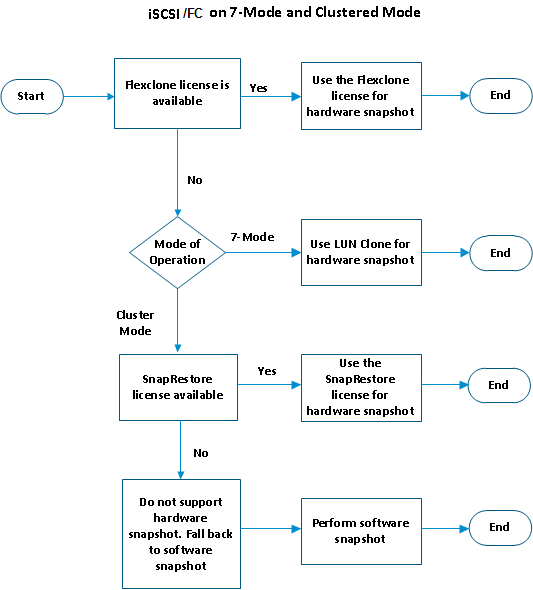Considerations for NetApp iSCSI/FC Support for VMware
Arcserve UDP provides hardware snapshot support for VMware virtual machine only when the underlying storage array is a NetApp storage array.
NetApp in 7-mode
If the NetApp storage system operates in the 7-mode, it is not mandatory to install any additional licenses to use hardware snapshots. However, we recommend that you have the FlexClone license installed.
NetApp in Cluster-mode
If the NetApp storage system operates in the Cluster mode (C-mode), you must have a FlexClone or SnapRestore license installed to use hardware snapshots.
The following flowchart explains the conditions applied to hardware snapshot for NetApp iSCSI/FC VMware:

Limitation of a LUN Clone
In a traditional LUN clone, sometimes the backup snapshot cannot be deleted during cleanup operations. Typically, a LUN exists as a file in the filesystem. So, a snapshot captures the file. When you create a LUN clone, another file gets created in the filesystem. So, the next snapshot captures the original file and the duplicate file. When multiple snapshots are captured, the LUN clone becomes a part of the snapshot chain. Now, if you delete a snapshot, the snapshot does not get deleted because it refers to a LUN clone which is, in turn, backed by another snapshot. In such cases, you cannot delete a snapshots until you delete the LUN clone and all the snapshots that reference that LUN clone. As a result, your retention policy for scheduled snapshots may be disrupted.
To avoid this situation, install the FlexClone license on your NetApp storage system and Arcserve UDP will use the FlexClone technology for LUN cloning.
Registry Keys for SnapRestore
When you use the SnapRestore license, restoring LUNs take a longer time depending on the size of the LUN and the environment. This is because deleting a snapshot takes a longer time as the snapshot is busy restoring LUN, which takes a longer time. Arcserve UDP does not have a mechanism to monitor the progress of restoring LUN. So, Arcserve UDP uses the retry mechanism for deleting the snapshot.
Arcserve UDP provides two registry keys (DeleteRetryTimeoutInMins and DeleteRetryCount) that you can use to improve the performance of snapshot deletion depending on the size of the LUN and the environment. The registry keys are at the following location:
SOFTWARE\Arcserve\Unified Data Protection\Engine
DeleteRetryTimeoutInMins
Specifies the timeout duration (in minutes) to delete a snapshot. If you only have SnapRestore and you do not have the FlexClone license, it is most likely that the snapshot deletion takes time. You can use the registry key to specify the custom values. However, it is advisable to use the FlexClone license.
For example, if the timeout duration is two minutes, UDP agent waits for two minutes for NetApp to delete the snapshot before sending the delete command to the NetApp storage array in its next retry. This registry key is used in combination with the DeleteRetryCount key.
Default value: 1 (in minutes)
Type: REG_SZ
DeleteRetryCount
Specifies the retry count to delete a snapshot.
For example, if the retry count is five, UDP agent will try for five times to send the snapshot delete command to the NetApp storage array. After retrying five times to send the snapshot delete command, if snapshot still exists, then you have to manually delete the snapshot and also, increase the retry count to the appropriate value so that next backup will not have this problem. This registry key is used in combination with the DeleteRetryTimeoutInMins key.
Default value: 30
Type: REG_SZ
Registry Keys for Disabling Lun Space Reservation
When Lun clone is performed during backup using hardware snapshot, by default space reservation is inherited from source Lun. Arcserve UDP provides a registry key that you can use to disable the space reservation. The registry key is at the following location:
HKEY_LOCAL_MACHINE\SOFTWARE\Arcserve\Unified Data Protection\Engine
DisableLunSpaceReservation =1
Specifies that the Lun space reservations are disabled.
Note: This is applicable only when FlexClone license is applied.